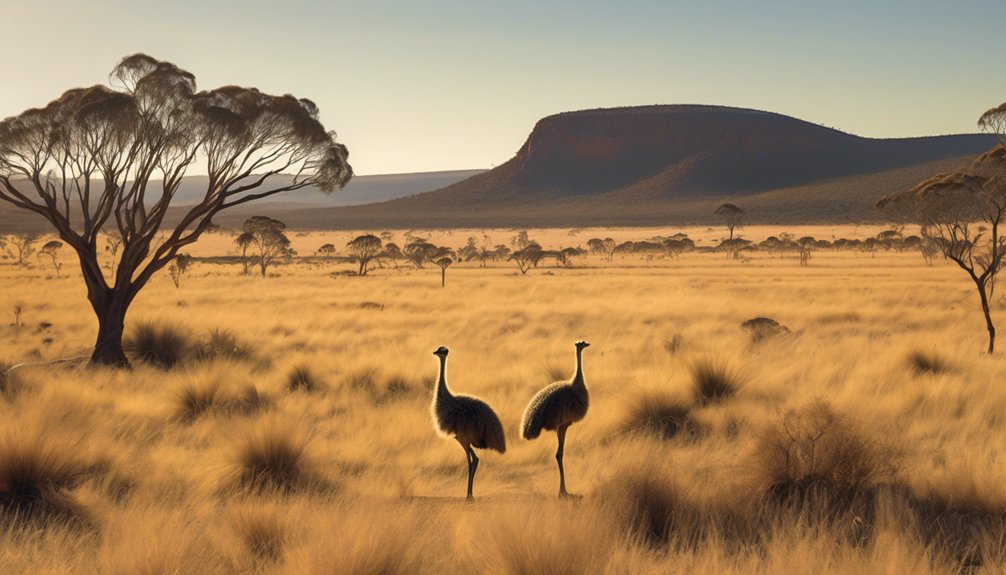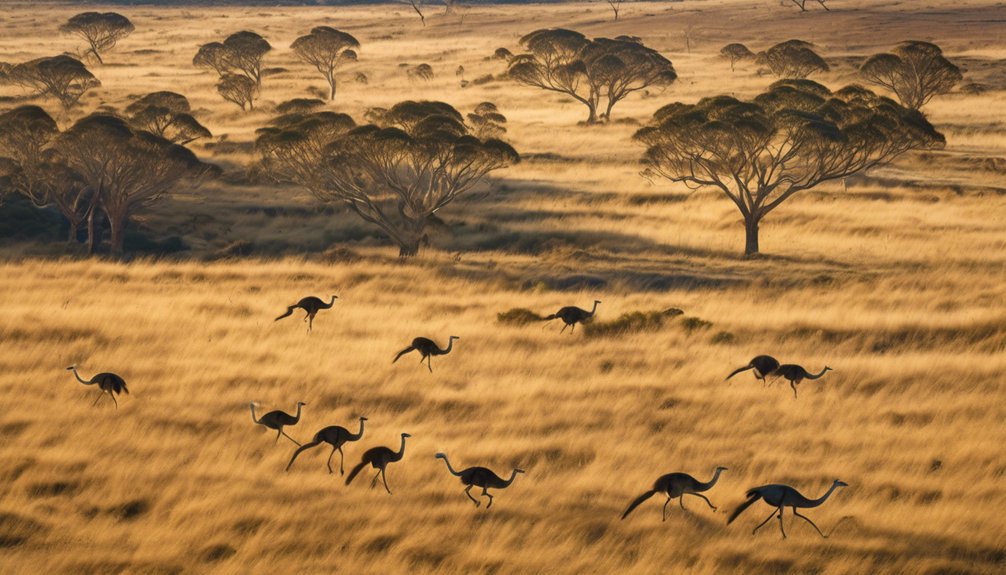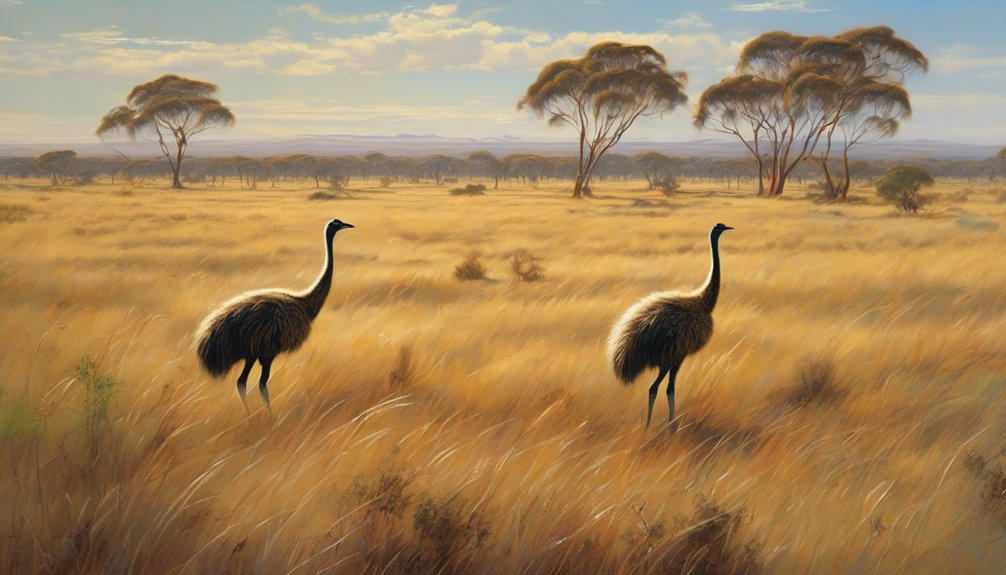
Consider the open forests of Victoria, where emus forage among eucalyptus trees. These large, flightless birds thrive in diverse ecosystems across Australia, each offering unique resources. Understanding where emus live is crucial to grasp their survival strategies. As you explore the different habitats, you'll uncover how these environments shape their behavior and adaptations, revealing the intricate relationship between emus and their surroundings. What makes each habitat uniquely suited for these remarkable birds?
Key Takeaways
- Emus are native to Australia, thriving in grasslands, forests, and scrublands across the continent.
- Open forests and eucalyptus habitats provide shelter and foraging opportunities for emus.
- Savannas feature grasslands with scattered trees, offering food and nesting spots.
- Grasslands are crucial for emus, supplying diverse food sources and space for social interactions.
- Semi-arid regions demand adaptations, such as efficient water conservation and mobility for survival.
Overview of Emu Distribution

Emus, native to Australia, primarily inhabit a range of environments, which can include grasslands, forests, and scrublands.
Understanding emu distribution involves examining their migration patterns and territory ranges. These birds typically roam vast areas, often traveling 20 to 30 kilometers daily in search of food and water.
Their territory ranges expand with the seasons, allowing them to adapt to changing conditions. During dry spells, emus may migrate to more fertile regions, demonstrating their resilience.
This dynamic movement not only ensures their survival but also influences the ecosystems they inhabit, as their foraging habits affect plant growth.
Open Forests as Emu Habitats
Open forests provide a unique habitat for emus, offering a blend of shelter and foraging opportunities. These environments often comprise various forest types, including eucalyptus and open woodlands, which support diverse flora and fauna. As you observe emu behaviors in these settings, you'll notice their foraging for seeds, fruits, and insects among the underbrush.
Here's a visual representation of emus in open forests:
| Forest Type | Emu Behaviors | Key Features |
|---|---|---|
| Eucalyptus Forest | Foraging for seeds | Tall trees, dense canopies |
| Open Woodlands | Nesting in shrubs | Sparse vegetation, open ground |
| Scrub Forest | Camouflaging behavior | Low shrubs, rich ground cover |
| Mixed Forest | Social interactions | Diverse plant life, varied terrain |
Savannas: A Home for Emus

While exploring the diverse habitats that support emu populations, savannas emerge as a vital environment characterized by their grasslands interspersed with scattered trees.
In this savanna ecosystem, you'll notice how emus thrive in their natural surroundings, exhibiting unique behaviors essential for survival.
Consider the following features that define their habitat:
- Open grasslands provide foraging opportunities for seeds and insects.
- Scattered trees offer shade and nesting spots, crucial for breeding.
- Seasonal rains create lush vegetation, sustaining both emus and their prey.
- Varied terrain allows for natural camouflage, helping them evade predators.
Emu behavior in savannas highlights their adaptability, showcasing how they navigate this intricate environment with grace and resilience.
Grasslands and Their Role in Emu Life
Grasslands play a crucial role in the lives of emus, offering essential resources that contribute to their survival and well-being.
These grassland ecosystems provide a diverse array of food sources, including seeds, fruits, and insects. You'll notice that emu behavior is heavily influenced by their environment; they forage throughout the day, searching for nutritious offerings in the open terrain.
The vast expanses allow them to maintain social structures, often seen in small groups, enhancing their safety. Additionally, grasslands offer open spaces for running, which is vital for their physical health.
Semi-Arid Regions: Adaptation and Survival

In semi-arid regions where water is scarce, emus have developed remarkable adaptations that enable them to thrive despite challenging conditions. Their survival strategies are fascinating and include:
- Efficient Water Conservation: Emus can metabolize water from the seeds they consume, reducing their dependency on external water sources.
- Heat Regulation: They've a unique ability to tolerate high temperatures, often foraging during cooler parts of the day to avoid overheating.
- Mobility: Emus roam large distances in search of scarce resources, adapting their movements based on seasonal changes.
- Social Behavior: They often form small groups, which enhances their protection and increases the chances of finding food and water.
These semi-arid adaptations highlight their resilience, allowing them to navigate the challenges of their environment gracefully.
Food Sources in Different Habitats
Emus adapt their foraging strategies to the diverse food sources available in various habitats. In grasslands, you'll find them munching on seeds, fruits, and insects that align with their dietary preferences.
In contrast, woodlands provide a different array of choices, where they might dig for roots or nibble on leaves. Their foraging behaviors are highly flexible; they can switch between these food sources based on seasonal availability.
This adaptability not only ensures their survival but also reflects their keen awareness of the environment. Understanding these interactions helps you appreciate how emus thrive across different landscapes, highlighting their role in maintaining ecosystem balance as they contribute to seed dispersal and nutrient cycling.
Seasonal Changes and Emu Movement

As the seasons shift, emus respond with notable changes in their movement patterns, driven by the availability of food and environmental conditions.
Their migration patterns are influenced by various seasonal behaviors, which include:
- Spring: Emus travel to find fresh grasses and seeds, vital for breeding.
- Summer: They often seek shade and water sources, adapting to the heat.
- Autumn: Emus gather in larger groups, foraging for ripe fruits and seeds.
- Winter: They may cover larger distances in search of sustenance, adapting to harsher conditions.
You'll notice how these patterns reveal their resilience, as they navigate the landscape's seasonal changes.
Conservation of Emu Habitats
While the emu's adaptability is remarkable, the conservation of their habitats is crucial for their survival.
As you delve into habitat preservation, consider how deforestation and urban development threaten these majestic birds. Maintaining their natural environment not only protects the emus but also sustains the delicate balance of the ecosystem.
Each action you take can have an ecological impact, whether through supporting conservation efforts or advocating for responsible land use. By understanding the interconnectedness of species, you can appreciate how preserving emu habitats contributes to biodiversity.
Every small effort matters, as it helps ensure that future generations can witness these iconic birds thriving in their natural settings.
Embrace the responsibility of protecting their homes; it's vital for both emus and our planet.
Frequently Asked Questions
How Do Emus Adapt to Urban Environments?
You'll find emus displaying remarkable urban survival skills by using adaptation strategies like foraging in parks and navigating traffic. Their ability to thrive in human-dominated spaces highlights their resilience and flexibility in changing environments.
What Predators Threaten Emus in Their Habitats?
You'll find that emus face various predator threats, including foxes and dingoes. To ensure their survival, habitat protection becomes essential, helping to minimize these risks and maintain a balanced ecosystem for these unique birds.
Do Emus Migrate Seasonally Like Other Birds?
Imagine a lone traveler, seeking warmth as seasons change. Emus don't migrate; they exhibit seasonal behavior, staying within their territory. Their migratory patterns are influenced by food availability, not long-distance travel like many birds.
What Role Do Emus Play in Their Ecosystem?
Emus act as vital seed dispersers in their ecosystems. By consuming various fruits and seeds, they help maintain ecosystem balance, promoting plant diversity. Their movement across landscapes supports healthy growth and regeneration of flora essential for stability.
How Do Climate Changes Affect Emu Populations?
Did you know that climate change could shrink emu populations by up to 50%? As temperatures rise, habitat loss intensifies, disrupting their breeding patterns and food sources, ultimately impacting their survival and ecosystem role.
Conclusion
In conclusion, emus thrive in diverse habitats, from open forests to grasslands, adapting uniquely to each environment. While some may argue that these birds are only found in isolated areas, their widespread distribution showcases their resilience and adaptability. Protecting their habitats is crucial, as it ensures their survival amid changing ecosystems. By understanding the intricate relationships between emus and their environments, we can better appreciate the importance of conservation efforts and the role these habitats play in their lives.




